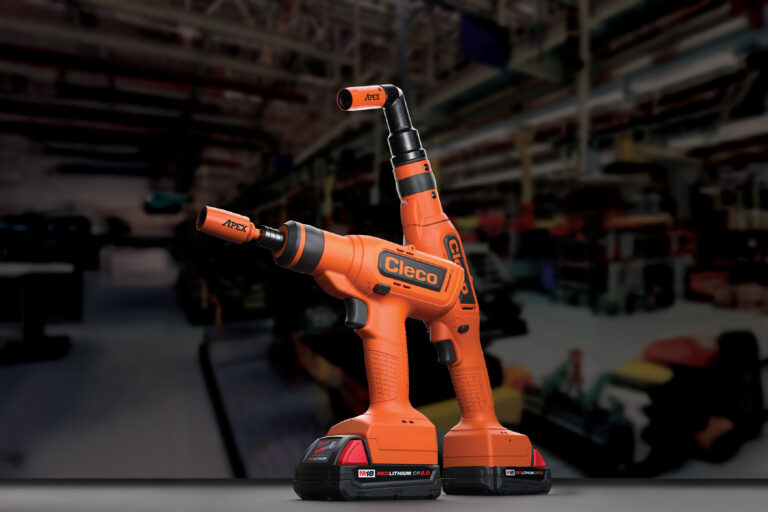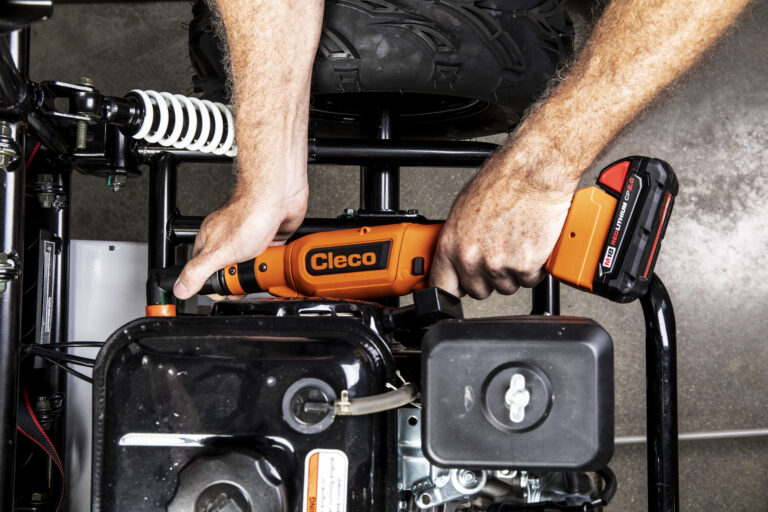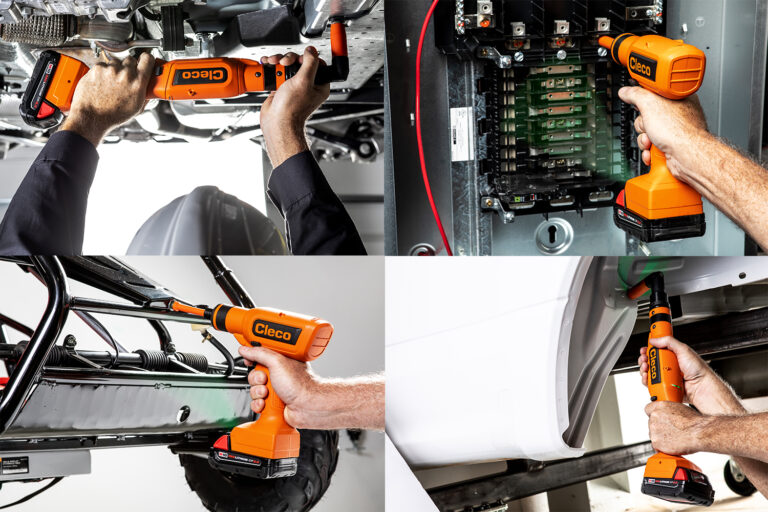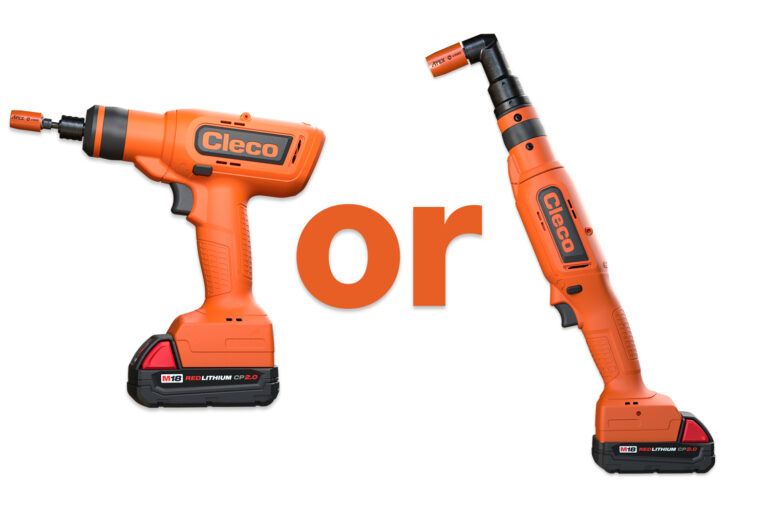
The Cleco CellClutch line of cordless assembly tools is a game-changer for industrial fastening. These tools marry the simplicity of a mechanical clutch with smart, programmable features to tackle common torque-related problems in assembly. From preventing over-tightening to eliminating cross-threading errors, CellClutch tools provide precise torque control in a user-friendly, portable package. In this article, we’ll explore the benefits and features of the CellClutch series, the ideal work environments for these tools, and how to choose the right CellClutch model for your needs.
Common Torque Challenges in Assembly
In many assembly operations, technicians face recurring problems related to torque consistency and quality control. Some typical challenges include:
- Over-Torque and Fastener Damage: Applying too much torque can strip threads or damage parts. Traditional tools without shut-off clutches rely on operator feel, which risks human error.
- Under-Torque and Loose Joints: Insufficient torque can lead to fasteners coming loose, compromising the assembly’s integrity.
- Cross-Threading and Stripped Threads: High-speed rundown of fasteners can cause crossthreading if alignment isn’t perfect, leading to scrap or rework.
- Missing Fasteners or Incomplete Batches: In multi-fastener assemblies, it’s easy to miss a screw or end up with an incomplete set of tightened fasteners without a counting method.
- Operator Fatigue and Error: Heavy pneumatic tools or corded electric tools with continuous hoses/ cables can be cumbersome, leading to operator fatigue. Fatigue increases the likelihood of mistakes in torque application.
- Setup Complexity: Adjusting torque output on older tools often requires trial-and-error or separate controllers, which slows down line changeovers.
How Cleco CellClutch Tools Solve Torque Problems
Cleco CellClutch cordless tools are engineered to make accurate torque application simple while introducing intelligent safeguards against errors. Here are key features that allow CellClutch to overcome common torque-related problems:

- Positive Shut-Off Clutch: Each CellClutch tool uses a mechanically adjustable clutch that shuts off the instant the set torque is reached. This contactless electronic cut-off prevents over-torque damage by stopping rotation exactly at the torque threshold. As a result, operators can avoid stripped threads and broken fasteners automatically, without relying on feel or guesswork.
- Programmable Multi-Stage Rundowns: Unlike basic clutch tools, CellClutch offers up to 7 programmable tightening stages via included software. You can set a slow initial speed for thread engagement, a higher speed for run-down, and a final slow stage for seating the fastener. By controlling RPM and torque in stages, the tool prevents cross-threading and double-hitting (retorqueing the same fastener) because it can detect anomalies in tightening angle or duration at each stage. If a fastener is cross-threaded or a second hit is attempted, the tool’s logic recognizes the irregularity and alerts the operator. This level of error-proofing was previously only available in far more expensive fully transducerized systems.
- Batch Count and OK/Not OK Alerts: Every CellClutch tool includes a batch counting function and status lights. Users can program the tool for a required number of fasteners in a batch. The tool then signals when the batch is complete – for example, a green “OK” light signals all screws in that set are tightened to spec, while a red “Not OK” light warns if any fastener is missing or if a re-hit/crossthread error was detected. This prevents the common issue of missing a screw or leaving a batch incomplete, thereby improving quality control on the line.
- Preset Torque with Simple Adjustment: Setting the desired torque on a CellClutch tool is quick and straightforward. Cleco describes the 3-step setup as “complete a rundown, read the torque, adjust the clutch, then verify with another rundown.” In practice, an operator or quality engineer will use a torque tester or the tool’s feedback lights to dial in the correct torque: make a test rundown, tweak the clutch setting with the provided adjustment tool, and test again to confirm the target torque is achieved. This fast commissioning process saves time when changing models or torque requirements, making CellClutch ideal for high-mix production lines where torque settings must be updated frequently.
- Built-In Feedback and Lighting: Each tool is equipped with an LED work light that illuminates the work surface. This improves visibility in cramped or dark areas, helping operators align fasteners properly to avoid cross-threading. In addition, multi-color indicator LEDs provide immediate feedback on each fastener and batch (green for pass, red for fail). The operator doesn’t need to interpret torque readings – the tool clearly indicates if the joint is OK or not. This reduces reliance on operator skill and lowers the chance of error in the assembly process.
- Consistent Accuracy: Thanks to the precision clutch and electronic control, CellClutch tools achieve high repeatability. In fact, the system is capable of a Cmk > 1.67 with ±10% tolerance, meaning it delivers very consistent torque results well within typical quality requirements. In real terms, this level of accuracy ensures each fastener is tightened correctly and consistently, which is critical for maintaining product quality and safety.
- Elimination of Cords and Hoses: As a cordless tool line powered by 18V lithium-ion batteries, CellClutch removes the need for air hoses or power cables. This immediately solves issues of operator fatigue and entanglement associated with pneumatic tools. The lightweight, well-balanced design further improves ergonomics. Operators can move freely around large assemblies or into tight spaces without being tethered, which helps maintain better posture and reduces strain. The cordless design also means no air pressure drop issues – each rundown gets consistent power, contributing to consistent torque on every fastener.
- Single Battery Platform: All CellClutch models use the Milwaukee M18 RedLithium battery system. If your facility already uses Milwaukee cordless tools, batteries are interchangeable, which reduces complexity. Even if not, the single battery type across the Cleco CellClutch (and other Cleco cordless lines) simplifies charging setups and spare battery inventory. This standardized battery platform is cost-effective and ensures that one charging station can serve all your CellClutch tools. The M18 batteries are known for robust performance, allowing the tools to complete hundreds of rundowns per charge. Plus, the CellClutch tools include a low-battery warning with auto shut-off – if the battery doesn’t have enough charge to achieve the set torque, the tool will stop, preventing under-torqued fasteners on account of a dying battery.
- Free Programming Software: Unlike some high-end DC tooling that requires purchasing software licenses, the CellClutch programming software is included at no extra charge. Users can connect the tool via USB to a PC to configure torque stages, speed settings, batch sizes, and even view tightening data. This free software lowers the cost of ownership and means even smaller operations can take full advantage of the tool’s capabilities without hidden fees. It also makes it easy to back up or replicate settings across multiple tools.
By combining these features, Cleco CellClutch tools directly address the pain points in assembly torque control. They offer error-proofing and quality assurance typically seen in far more expensive systems, but in a simple, cordless tool that any technician can use with minimal training.
Ideal Work Environments for CellClutch Tools

The versatility of the CellClutch line makes it suitable for a broad range of industrial environments. Here are some scenarios where these tools excel:
- Automotive and Transportation Assembly: In automotive manufacturing or heavy truck assembly, numerous fasteners must be tightened to specification without fail. CellClutch nutrunners can be used on assembly lines for engines, drivetrain components, chassis, and interior assembly. The cordless design eases movement around large vehicles, and the batch count feature ensures, for example, that all required bolts in a pattern are accounted for on each unit. For safety-critical bolts (like those in seat structures or airbags), the CellClutch Connect versions provide traceability and data logging of each torque cycle, enhancing quality assurance.
- Appliance and Equipment Manufacturing: Assembly of appliances, power tools, HVAC units, and industrial equipment often involves many functional fasteners that need correct torque but aren’t individually trace-critical. CellClutch tools shine in these applications by preventing stripped plastic bosses or metal threads through accurate shut-off. Manufacturers of products like refrigerators, washing machines, and compressors can replace pneumatic screwdrivers with CellClutch cordless screwdrivers to eliminate hoses and improve error-proofing. The quick torque adjustability is especially useful on production lines that assemble multiple product models with different fastener sizes or torque specs.
- Electronics and Light Assembly: For lower torque ranges (the pistol models go as low as about 1 Nm), electronic device assembly or electrical panel building benefits from the precise torque control. Small screws in electronics are easy to overtighten or leave loose. A CellClutch pistol grip screwdriver (for example, the model covering 1.1–4 Nm) can replace manual torque screwdrivers or basic clutch drivers, speeding up assembly while ensuring every tiny screw is snugged just right. The tool’s LED ‘OK/NOT OK’ feedback gives assemblers immediate confirmation that each fastening is done correctly without needing to manually check with a torque wrench or gauge.
- Aerospace and Defense Manufacturing: These sectors demand very high quality control. While certain critical fasteners still require advanced transducerized tools with angle monitoring and full traceability, many assembly tasks can be handled efficiently by CellClutch tools. For instance, nonstructural assemblies, panels, and interior components of aircraft or military equipment often involve numerous fasteners that must be tightened consistently. The ability to program multi-stage tightening prevents damage to expensive components by controlling how torque is applied at each step. The cordless aspect helps technicians maneuver around large airframes or vehicles without dragging hoses or cords. And for documentation purposes, the Connect versions can integrate with plant quality systems to log every fastening event.
- Maintenance, Repair & Operations (MRO): Maintenance crews can greatly benefit from CellClutch cordless tools for equipment repairs and installations. When working in the field or across a large facility, dragging an air compressor or searching for outlets is inconvenient. A battery-powered CellClutch tool provides the freedom to perform torque-critical fastening (such as on machinery, flanges, or assembly of replacement parts) with the assurance that the set torque will be achieved. The single battery platform and quick chargers mean minimal downtime – a fresh battery keeps the work going. MRO tasks often involve varied fastener sizes and types, so the quick torque setting process is appreciated when moving between different jobs or equipment types.
- General Manufacturing and Fabrication: Any production environment looking to upgrade from outdated clutch tools or inconsistent manual processes can benefit from CellClutch. In many factories, CellClutch is “the perfect upgrade from pneumatic tools.” Small job shops to large manufacturing plants can deploy these tools to reduce rework and scrap caused by torque errors. Even where absolute digital traceability isn’t required, improving first-pass yield by avoiding stripped screws and missed fasteners has a direct positive impact on productivity and quality. The tools are also straightforward for operators to learn, which simplifies the adoption in environments where various teams or shifts will use the equipment.
The vast majority of general industrial tool users across assembly and maintenance fields will find many uses for CellClutch. If your current process involves multiple operators using pneumatic clutch screwdrivers (and you occasionally see quality issues due to under/over-tightening), these cordless tools could significantly improve your results and reduce those issues.

Within the CellClutch product line, Cleco offers both pistol grip screwdrivers and right-angle nutrunners, each in several torque capacities. Choosing the right model involves evaluating your torque requirements, access space, and whether connectivity is needed. Here’s a breakdown to guide your selection:
- Torque Range and Model Numbers: CellClutch tools cover a torque spectrum from roughly 1 Nm up to 65 Nm across different models. The pistol grip series (model numbers starting with CLBP) are available in three torque ranges: for example, CLBP04Q covers approximately 1.1–4 Nm, CLBP08Q covers 2.1–8 Nm, and CLBP12Q goes up to about 12 Nm. These are ideal for small to medium fasteners. For higher torque applications, the right-angle series (models starting with CLBA) pick up where the pistols leave off: e.g., CLBA203 handles ~8–21 Nm, CLBA303 about 8–30 Nm, and the largest – CLBA653 – reaches 65 Nm (about 48 ft-lbs). When choosing, select a model where your target torque falls well within its range (ideally mid-range) for best performance. If you need to cover a wide variety of torque values, you might employ multiple models – the good news is that they all share the same batteries and basic interface, so operators can switch between tools easily.
- Pistol Grip vs. Right Angle: The decision between pistol and right-angle form factors comes down to assembly geometry and operator comfort. Pistol grip screwdrivers are held like a typical drill, making them suitable for vertical or easily accessible fasteners where you can approach straight-on. They are usually lighter in weight (around 2.3 lbs or ~1 kg without battery) and have a 1/4″ hex quickchange chuck for driver bits, which is perfect for common screw sizes in electronics, appliances, or general assembly.
Right-angle nutrunners, by contrast, have a 90-degree head with typically a square drive (3/8″ drive on most CellClutch models) for sockets. These are better for fasteners in tight or recessed locations where a pistol tool won’t fit, or for horizontal fasteners where a pistol’s length would be awkward. The right-angle design also allows the operator to brace reaction torque against a workpiece or jig, which becomes important at higher torques – using a pistol grip for 30+ Nm tasks can strain the wrist, whereas a right-angle tool can be more comfortably supported. If your assemblies have many bolts in confined spaces (like inside machinery or under assemblies), the angle tool is likely the better choice. Many operations will use a mix of both: pistol tools for lighter torque and open access situations, and angle tools for higher torque or hard-to-reach fasteners.
- Accessory Considerations: All CellClutch tools use the Milwaukee M18 batteries, which come in various capacities (e.g., 2.0 Ah for lighter weight or 5.0 Ah for longer runtime). Consider your usage cycle – for continuous production use, the higher capacity batteries or multiple spares might be warranted so one can charge while one is in use. Cleco also offers optional protective covers for these tools (often silicone-free to avoid paint shop contamination) which can be useful if the tool might contact sensitive surfaces. Additionally, if you’re buying the tools, don’t forget to order the required chargers and any specific drive adapters or socket sets needed for your fasteners. The pistol models will need 1/4” hex bits (and possibly adapters for different bit styles), while the angle models will use standard impact sockets of the appropriate drive size (3/8” for most, possibly 1/2” if any larger model exists in the series).
By evaluating these factors – the torque needed, the physical access to fasteners, and whether you need connectivity – you can select the optimal CellClutch tool or combination of tools. For example, a general manufacturing line might deploy a CLBP08Q pistol for small screws and a CLBA303 right-angle for larger bolts. Both would share batteries and have the same user interface, simplifying training and maintenance.
Cleco’s CellClutch line demonstrates that torque clutch tools don’t have to be basic – they can be smart, connected, and highly reliable. By solving common assembly issues like over-torque, under-torque, cross-threading, and missing fasteners, CellClutch tools help manufacturers improve quality without overcomplicating the process. Operators get a lightweight, cordless tool that is easy to handle, while engineers get the peace of mind of consistent, programmable torque control. Whether you’re upgrading an assembly line from pneumatics or seeking a more capable cordless screwdriver for maintenance work, Cleco CellClutch provides a range of options to fit your needs. Embracing these tools can lead to fewer errors, less rework, and a safer, more productive work environment – all of which positively impact the bottom line in any industrial operation.
Many operations actually use a combination of these tools: for example, a factory might use cam-over wrenches on the line for repeatability, then use dial or electronic wrenches for auditing and calibration verification. By understanding the differences – how each wrench works and where it excels – you can select the optimal torque solution for your application, ensuring bolts are tightened accurately, efficiently, and safely every time.
